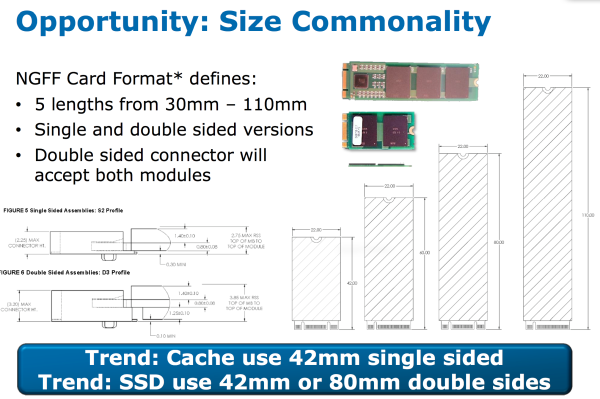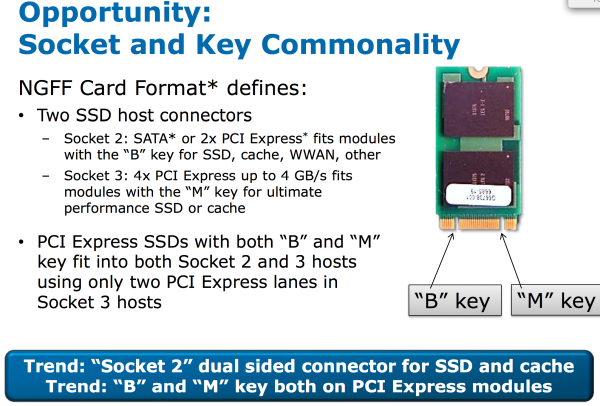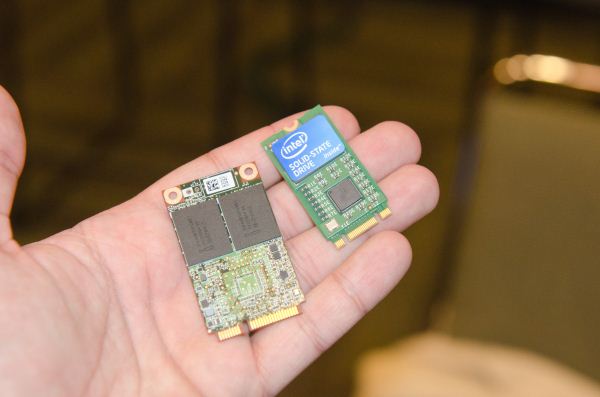NGFF SSDs: Putting an End to Proprietary Ultrabook SSD Form Factors
by Anand Lal Shimpi on September 13, 2012 2:32 PM ESTWe've seen a bunch of custom SSD form factors with the arrival of Ultrabooks as well as systems like the MacBook Air and Retina MacBook Pro. The need is simple: standard 7mm or 9.5mm SSDs are too big for some of these machines, and you don't actually need all of that volume to build a fast drive. mSATA cards work as a small form factor solution but they are only available in a single size. We need flexibility both on length (to allow for higher capacities) as well as on the interface side to enable higher performance. The NGFF specification gives us just that.
The spec allows for SATA, PCIe x2 or PCIe x4 interfaces. It also includes definitions for five different card lengths.
The proposed spec includes two connector definitions: Socket 2 and Socket 3. Socket 2 allows for SATA or PCIe x2 interface for SSDs, WWAN or other non-storage devices. Socket 3 is strictly for high-performance storage, offering up to 4GB/s of bandwidth in a tiny little package.
This is super exciting as far as I'm concerned. We've strayed too far from standardization and upgradability in the pursuit of ultimate mobility. Now all we need is a smaller form factor user replaceable memory standard.
Update: I just got some hands on shots with a few NGFF samples:
mSATA on the left, NGFF on the right



















41 Comments
View All Comments
quiksilvr - Saturday, September 15, 2012 - link
They could have just used microusb 3.0 if speed was the concern and integrate MHL.Guspaz - Saturday, September 15, 2012 - link
micro USB is pretty horrible; instead of adding additional pins to the existing micro USB connector (as Samsung did on the GS3), they designed a monstrosity of a connector that is twice as large and has two distinct connectors. The damned thing is the same width as a full-sized USB connector.darwiniandude - Saturday, September 15, 2012 - link
Bur far more fragile. Even full size USB is pretty fragile, gets squashed etc but the microUSB3 connectors are terrible, as you say.Bleakwise - Friday, February 12, 2016 - link
You want to talk about wide connectors? My iPhone 4s (2014) has a connector that is 4-5x wider than the USB connector on my "ObamaPhone" (free for all, so why not get one?) that looks like it was manufactured in China sometime in the last decade....Bleakwise - Friday, February 12, 2016 - link
Also I've had to replace my CrAplpePhone connector cable about 3x since I got it. Meanwhile my Obamaphone I got back in 2011 is still working fine with it's original cable, as are all my Kindles, my Android from 2010, my Kodack Digital Camera, and some el-cheapo external hard drive dock I got back around the turn of the century.Bleakwise - Friday, February 12, 2016 - link
Here. If anyone is having trouble understanding....http://www.mobilefun.co.uk/blog/wp-content/uploads...
Bleakwise - Friday, February 12, 2016 - link
That said, if Apple really wanted to impress me, they would have made the 30 pin connector also take regular micro USB, but then have extra plastic on the sides to keep it from wiggling around and breaking, but also let me plug it in to my Kindle charger if I had a drink and forgot it it at a New Years dinner or w/e.erikwpotter - Friday, September 14, 2012 - link
While we're being persnickety, nobody was talking about ISO standards until you chose to refocus solely on standards defined by a single standards organization of your choosing and/or only standards that are unencumbered by patents of any kind.Are we to assume by implication that you believe NGFF standards (and by association the PCI, PCIe, & SATA standards it supports) are ISO certified and free of all proprietary technologies and unencumbered by patents?
bsd228 - Friday, September 14, 2012 - link
This is a pretty silly list, generated on the notion that throwing a lot of crap against the wall will make it a compelling argument. But come on - Apple doesn't have a choice on accepting jpg/gif/pdf....these are document formats that people need to be able to access. It has nothing to do with how the hardware level behaves.The new iphone rejected a standard micro-USB that is used by everything else on earth and came up with their own new compact plug. It does offer an advantage in working in both directions, but still requires people to maintain a second set of connectors and chargers. Likewise, it would be no surprise that they would prefer to keep a proprietary connection for small form factor SSDs so they can continue to charge huge premiums for 512G laptops, lest buyers get the 256G one and replace it themselves.
erikwpotter - Saturday, September 15, 2012 - link
Ok, so let me summarize to make sure I understand your argument.1) danjw asks when in recent memory Apple went along with an industry standard that they didn't start
2) A list of standards supported in a new Apple product announced the day before is posted to present facts to challenge danjw's claim. Yes some standards listed seriously and some, admittedly, more jokingly though still truthfully.
3) You claim the list is "pretty silly" and that the long list of factual challenges to danjw's claim is not a "compelling argument", yet only chose to note an exception to one of them that you claim Apple had no choice but to accept. Even that single claim fails to challenge the truth of the statement, instead accepting the truth with only the assertion that Apple had no choice. This still goes to show that Apple was supporting a standard they didn't start.
4) Then we get to something tasty. You don't like that Apple chose to continue using a port of their design rather than move to micro-USB. That is of course your choice.
However, others may prefer the proprietary choice over the less functional alternative. After all it offers all the functionality that micro-USB offers, including plugging into USB, and it provides additional functionality that is absent from USB that some consumers value having access to. You yourself admit to one of the other advantages it offers, weakening your own argument. Other things that consumers may benefit from include the audio/video output capabilities the port provides.
The downside argument is that it sill requires people to maintain a second set of connectors and chargers...well there are a number of people out there that don't own a single micro-USB cable or charger. I've got one on my camera and I never use it because the battery charges faster when I put it in its proprietary wall charger. Additionally that camera has to also have a second connector for HDMI because USB can't handle the audio/video output. If only my camera had a single port that could handle both tasks and charge my battery faster.
Whether or not Apple moves to adopt this new standard in the future remains to be seen. Given that NGFF didn't exist when Apple last updated their laptops, and that it is in fact still in a draft state and is a non-existing product used by nobody, it is "pretty silly" to complain that Apple has not used it yet.